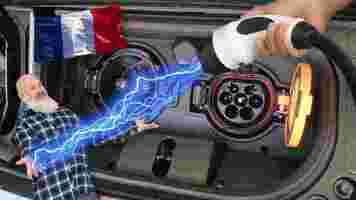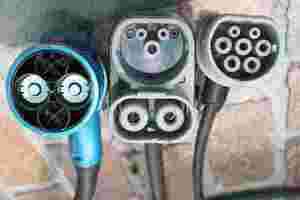France says ‘au revoir’ to CHAdeMO, the EV charging standard
Is this the beginning of the end for the CHAdeMO electric vehicle charging standard? Its days certainly look numbered, in France at least.

Earlier this month, the French government amended a 2017 regulation , ending the requirement that all new DC fast-chargers must offer a CHAdeMO connector.
Instead, all new chargers will have to offer the significantly more widely used CCS connector for fast DC charging or Type 2 connector for standard AC charging.
While CHAdeMO is no longer a legal requirement, it hasn’t been outright banned.


EV charging providers can still provide a CHAdeMO charger if they want, although, there seems to be no point as the CCS standard is far more popular in Europe.
CHAdeMO was created by a consortium of Japanese carmakers, and as such, tends to be quite popular on EVs from the country.
The Nissan Leaf is one of the few popular EVs in Europe to have the CHAdeMo charger.
However, Nissan is now moving away from the standard. Its upcoming Ariya electric SUV — Nissan’s first EV in 10 years — will adopt the CCS connector instead. Suggesting the end is nigh for CHAdeMO.
France‘s regulatory move isn’t exactly a death knell for the EV charging standard, though. It seems CHAdeMO will fall away slowly into nothingness as manufacturers favor CCS. It’s HD DVD and Blu-ray all over again.
Or maybe CHAdeMO will be one of those quirky things they only have in Japan.
HT – Electrive
Do EVs excite your electrons? Do ebikes get your wheels spinning? Do self-driving cars get you all charged up?
Then you need the weekly SHIFT newsletter in your life. Click here to sign up .
A Hyundai is now an air purifier — and 3 other ways car parts are getting a second life
With carmakers committed to sustainability targets for incoming decades, they are finding second life use cases for discarded cars and their components.

Recently, Hyundai has found a new way to give a second life to preproduction prototypes. Rather than conventionally crushing them or using them for accident testing, it’s released a video showcasing a “rebirth” of various Ioniq 5 car components to create an air purifier. Hyundai originally built the test car for noise, vibration, and harshness tests.


The air purifier’s functionality comes from the original car cabin air filter and cooling fan. A 50 cm alloy wheel tops the air purifier case, with its side panels made from bits of the car’s doors and hood.
The casing is decorated with the Ioniq 5’s emblem pixelated LED taillamps and the digital instrument cluster readout.
This particular upcycling is admittedly more about marketing than creating functional retail or mass-market products. But it’s part of a more significant trend of circular design , which considers the lifespan of product design beyond its original purpose. This is particularly big when it comes to repurposing EV batteries.
Second life batteries are big business
Lithium-ion batteries generally last about 10 -15 years in powering an electric vehicle. However, they have a residual capacity of more than 80 percent beyond their vehicle functionality.
As a result, they are being increasingly used for stationary electricity storage systems, where they are cheaper than new cells and can live for a further 10 years.
Further, the carbon emissions generated when the batteries were produced are spread sustainably across two service lives — one in the car and one in the storage system.
´
In Germany, a joint energy transition project between RWE and Audi is using 60 decommissioned lithium-ion batteries to provide temporary storage for about 4.5-megawatt-hours of electricity at the site of the RWE pumped-storage power plant in Herdecke, North Rhine-Westphalia.
In Japan, rail operators are replacing batteries in emergency power supplies at railroad crossings with used batteries from Nissan Leafs .
Even better, unlike lead-acid batteries, these repurposed lithium-ion batteries come with a control system attached, making it possible to check the battery’s status remotely. This facilitates predictive maintenance, informing rail staff of the battery’s status before its voltage becomes too low.
A second life limited by poor uniformity
McKinsey and Co predict that the second life battery supply for stationary applications could exceed 200 gigawatt-hours per year by 2030. However, they highlight several barriers to this, including:
Refurbishing complexity due to lack of standardization and fragmentation of volume.
The absence of standards regarding guarantees regarding second life battery quality or performance.
A lack of standard performance specifications for second-life applications.
An opportunity for new business models
McKinsey also suggests that the trend of car buyers owning EV batteries may shift due to their residual value in second life applications. This may result in a model of EV battery leasing which enables the auto or battery maker to maintain ownership of the battery’s second revenue stream.
It’s a model we’ve already seen in Ather and Bounce scooters in India. In Germany, Swobbee has created an alternative business model, facilitating battery sharing for escooters and ebikes. It will be interesting to see what kinds of solutions evolve for EV auto batteries.
Berlin revamps its inner city with new ‘pedestrian protection laws’
This article was originally published by Christopher Carey on Cities Today , the leading news platform on urban mobility and innovation, reaching an international audience of city leaders. For the latest updates follow Cities Today on Twitter , Facebook , LinkedIn , Instagram , and YouTube , or sign up for Cities Today News.

Berlin has introduced a law elevating the status of pedestrians and making its mobility ecosystem more usable for wheelchair users and the visually impaired.
The so-called ‘pedestrian law’ – an amendment of the city’s 2018 Mobility Act – was passed by the state parliament at the end of January and is the first time a German city has put pedestrian travel on a legislative footing.
The new legislation requires each of Berlin’s 12 districts to develop a relevant pilot project within three years.
“[This] law further pushes the city’s transformation from car-first to pedestrian-first, to improve the quality of life for all Berliners,” Harald Moritz, Berlin Greens Parliamentary Transportation spokesperson, said in a statement.
Measures included in the amendment include longer green lights for pedestrians; safer school routes for children; more pedestrian crossings and benches; lowering kerbs to make them more wheelchair accessible; and a crackdown on illegal parking and dangerous driving.
Construction sites will also need to ensure that pedestrians and cyclists can safely navigate around them, and cyclists will face stricter enforcement for riding and parking on pavements.
Berlin Mobility Act
In July 2018 Berlin’s Senate Department for the Environment, Transport, and Climate Protection passed a law to provide safer and more climate-friendly transport within the city. The Berlin Mobility Act was aimed at improving cyclist welfare by redesigning dangerous junctions, expanding spending on cycling infrastructure and parking facilities, and creating safe bicycle lanes along all main roads.
The law was primarily introduced to reduce the number of deaths or serious injuries from traffic accidents — in 2020, almost 75% of the 50 traffic fatalities recorded in Berlin were pedestrians or cyclists.
According to the European Transport Safety Council fatalities from motor vehicle accidents across the European Union fell by almost 25% between 2010 and 2018, with pedestrian fatalities falling by 19% – but Germany was below the EU average in a year-on-year reduction in pedestrian fatalities.
SHIFT is brought to you by Polestar. It’s time to accelerate the shift to sustainable mobility. That is why Polestar combines electric driving with cutting-edge design and thrilling performance. Find out how .